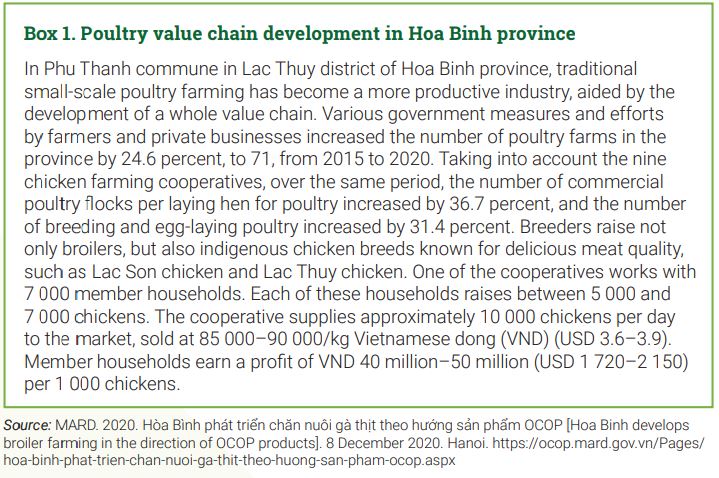Viet Nam: One Commune One Product programme reduces the urban–rural divide
OCOP Case Study Series
26/06/2023

©MARD - Viet Nam
Viet Nam is struggling with high poverty rates in rural areas, leading to a sharp urban–rural divide and urban flight. Activities undertaken under the One Commune One Product (OCOP) programme are intended to boost the competitiveness of local products. Initiated in 2018, the programme has raised the competitiveness of 8 478 products throughout the country.
Key issues: need to accelerate rural economic development to reduce rural–urban inequality
In Viet Nam, the rural economy is lagging the urban economy due to inadequate human capacity, market linkage and enterprise development, among other factors. Nearly 30 million Vietnamese have been lifted out of poverty since the 1990s, but this has resulted in higher poverty rates in rural areas, which is nearly three times the urban rate. It has also accelerated urban migration, reducing the share of the rural population by 13 percentage points in the past 20 years.
Solutions: National Government scales out the One Village One Product (OVOP) concept nationally
To turn around slow economic development in rural areas, rural businesses and product value chains need to be strengthened. In response, the National Government, by Decision No. 490/QD-TTg of the Prime Minister, adopted the One Commune One Product programme for nationwide implementation under the National Target Program (NTP) for New Rural Development in 2018. The programme aims to develop the rural economy by upgrading rural businesses and promoting value addition to local resources and value chain development.
Background: the OVOP concept has been implemented at the provincial level since 2008
The rural population of Viet Nam accounted for 61.95 percent of the total population of 98 million in 2021, according to World Development Indicators. The poverty rate in the rural area is almost three times that in the urban area, and the earnings of workers in rural areas, on average, is less than 50 percent of their counterparts in urban areas (IFAD, 2016). The slow growth of the rural economy can partly be attributed to inadequate attention paid to value chain development and enterprise creation, which, in turn, has widened rural–urban inequality and led to urban migration. The Government launched the NTP for New Rural Development in 2010 to narrow the gap.
The concept of the OVOP movement, which originated in Japan in 1979, was piloted in four provinces in Viet Nam between 2008 and 2011. Viet Nam also hosted an international OVOP seminar in 2010 and gained knowledge on OVOP from countries, such as Japan and Thailand. In 2013, Quang Ninh province in the northeastern part of Viet Nam initiated the OCOP programme.
Implementation: business development to market linkage
The OCOP programme aims to promote the use of internal resources, such as local wisdom, creativity, human resources, raw materials and local culture, increase product values and employment, and raise the income of rural residents. Three specific measures of the programme are as follows:
(1) Capacity development of OCOP producers: The programme provides training to OCOP producers in different areas in order to develop value chains of specialties and traditional products of each locality with private sector stakeholders. The subject matters cover business and organizational management, product development with innovative and creative ideas, production skills, quality management, food safety, packaging and labelling, intellectual property, traceability along the value chain and marketing.
(2) Classification of the OCOP products: To assess and encourage producers to improve the quality of their products, the OCOP products are classified into five categories, ranging from 5-star to 1-star (5-star being the best), following the OTOP Product Champion model of Thailand. The evaluation is conducted based on the following criteria: (1) products and community strength, 35 points; (2) marketing ability, 25 points; and (3) product quality, 40 points. Supervision and inspection of the products are conducted from time to time, especially with regard to food quality and safety.
(3) Marketing and promotion: A series of marketing and promotional support is provided to the OCOP producers to connect them with customers and to introduce the unique cultural values behind the products locally, nationally and internationally. Such measures include, for example, organizing forums, exhibitions, the OCOP Week event, awarding events and live stream events, at provincial and national levels. Tourist centres and cultural activities are also used as marketing channels and logistics systems are being improved to promote domestic trade and export.
As of August 2022, 8 478 OCOP products in all of the country’s 63 provinces had achieved a rating of 3 stars or more, including 20 5-star products (MARD, 2022). Food and beverage items are the predominant types of products, accounting for 80.8 percent and 6.9 percent of the total, respectively. The others are herbal products, garments and handicrafts. There are currently more than 4 350 OCOP producers, consisting of cooperatives, small and medium-scale enterprises, individual businesses and households.
Impact
Rural economic and social development in Viet Nam has recently been revitalized. More than 60 percent of the OCOP producers with 3 stars or higher have, on average, increased their annual revenue by 17.6 percent (Nguyen, 2021). An example of the rural business development is explained in Box 1.

Key resources
IFAD (International Fund for Agricultural Development). 2016. Review of experience of the National Target Program for New Rural Development – Viet Nam. Policy Case Studies. Rome. https://www.ifad.org/ documents/38714170/39135645/ Policy+c ase+study+ Viet+Nam+% E2%80%93 +Review+of+ experience +of+the+ National+Targ et+ Program+ for+new+rural +developm ent.pdf/bf68c25c-7489-4 b06 -b5ca-309 c9e4ab0f
MARD (Ministry of Agriculture and Rural Development). 2022. Xây dựng OCOP từ việc chính người lãnh đạo mang sản phẩm đi bán [Building OCOP from the leader who brought the product to sell]. 12 September 2022. Hanoi. Cited 22 September 2022. https://ocop. mard.gov.vn/Pages/xay-dungocop-tu-viec-chinh-nguoi-lanh-daomang-san-pham-di-ban.aspx
Nguyen, M. T. 2021. Vietnam’s “One Commune, One Product” Program. Presentation at Webinar on Stocktaking and Lessons Learned from the Implementation of One Village-One Product in Asia and the Pacific, 30 June 2021. Rome, FAO. https://www.fao.org/3/cb5641en/ cb5641en.pdf
One Commune One Product website (Vietnamese only) https://ocop.mard.gov.vn/
